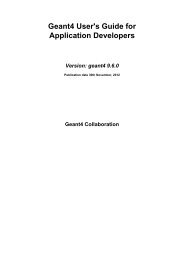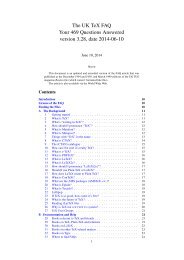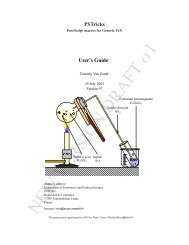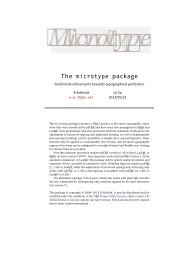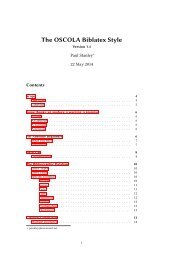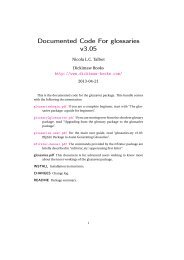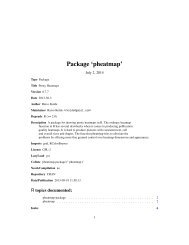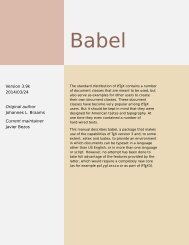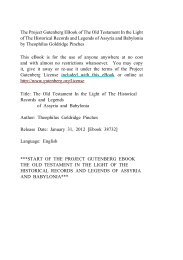User's Guide to biblatex philosophy
User's Guide to biblatex philosophy
User's Guide to biblatex philosophy
Create successful ePaper yourself
Turn your PDF publications into a flip-book with our unique Google optimized e-Paper software.
© 2009–2014 Ivan Valbusa 4<br />
Jules-Henri Poincaré (1968), La science et l’hypothèse, Flammarion, Paris; trans. as La scienza e l’ipotesi, ed. by<br />
Corrado Sinigaglia, Bompiani, Milano 2003.<br />
@book{Poincare:1968-ORIG,<br />
author = {Jules-Henri Poincaré},<br />
title = {La science et l’hypothèse},<br />
publisher = {Flammarion},<br />
location = {Paris},<br />
date = {1968},<br />
related = {Poincare:1968-ITA}}<br />
@book{Poincare:1968-ITA,<br />
author = {Jules-Henri Poincaré},<br />
edi<strong>to</strong>r = {Corrado Sinigaglia},<br />
title = {La scienza e l’ipotesi},<br />
publisher = {Bompiani},<br />
location = {Milano}}<br />
Since Biber 1.6 you can have cascading relations <strong>to</strong>o (☞ Popper 1934).<br />
@Book{key1,<br />
...<br />
related = {key2},<br />
...<br />
}<br />
@Book{key2,<br />
...<br />
related = {key3},<br />
@Book{key3,<br />
...<br />
}<br />
The related entry is preceded by the translationas string which defaults <strong>to</strong> “trad. it.” for Italian documents and<br />
“trans. as” for English documents. If you want <strong>to</strong> change it, use the relatedstring field. For example:<br />
@book{Poincare:1968-ORIG,<br />
author = {Jules-Henri Poincaré},<br />
...<br />
related = {Poincare:1968-ITA},<br />
relatedstring = {ed.~it.}}<br />
4 Classical and undated works<br />
The treatment of the classical works and other writings with uncertain or omitted date is particularly difficult and<br />
inevitably imposes some choices.<br />
If there is a critical edition you should cite it directly, such as ☞Heidegger (2001). If you do not like this anachronistic<br />
label you may use the shorthand field, such as ☞Kant (1968b [henceforth cited as KpV]). Note that a “shorthand intro”<br />
is au<strong>to</strong>matically printed when the entry is cited for the first time and omitted afterwards. To turn off this capability load<br />
the option shorthandintro=false. In this case you will need a list of shorthands (\printshorthands command). If<br />
you do not like these solutions you can use the entrysubtype field with classic value (see section 7) or the \sdcite<br />
command (section 11).<br />
5 Crossreferences<br />
The <strong>philosophy</strong> styles allow you <strong>to</strong> manage entries referring <strong>to</strong> other entries through the crossref fields. This<br />
is very useful when you have <strong>to</strong> cite two or more @incollection of the same @collection (☞ Corrocher 2009;<br />
Federspil and Vet<strong>to</strong>r 2009). In this way the @collection is printed in the bibliography and is cross-referenced inside<br />
the @incollection, using the corresponding author-year label (the mechanism is the same for @inbook items).<br />
When you have <strong>to</strong> cite only one @incollection of a single @collection you have three choices:<br />
<strong>biblatex</strong>-<strong>philosophy</strong> v0.9f – 2014/03/28



